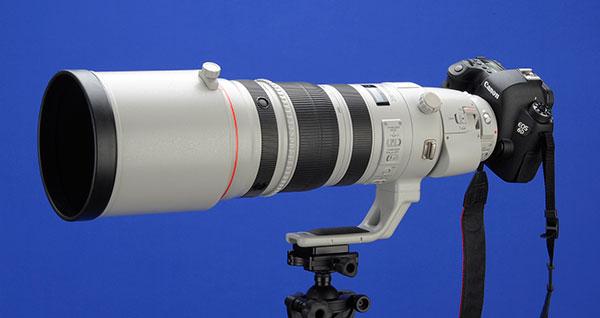Canon EF 200-400mm f/4L IS USM Extender 1.4x Lens Review

A lens aficionado once told me, “the more reach you have, the more you want.” This remark, of course, was directed at the wide array of telephoto lenses available today for outdoor photographers and their obsession with getting up close and personal with wildlife.
Apparently, Canon heard this call amongst wildlife photographers for “more reach” and introduced the Canon EF 200-400mm f/4L IS USM Extender 1.4x. With this impressive (but pricey) piece of Canon glass, no longer will you go wanting for greater focal lengths. Now, all you do is flip a lever on the lens and you can virtually double its focal length. (Ok, maybe I exagerrate. But only slightly!)
Ever since Nikon introduced its version of this lens, Canon owners have been asking for a model of their own. A few years ago they got it when Canon introduced the EF 200-400mm f/4L IS USM Extender 1.4x. This super telephoto zoom has been in such demand since its debut that I’ve had trouble securing a loaner. Recently however, the stars aligned and I was able to get my hands on this marvel of a lens and put it through its paces for this review.

Build & Features
The Canon EF 200-400mm f/4L IS USM Extender 1.4x is an innovative lens that combines all of the features most photographers want in a long zoom but with a very important twist. Aside from the image stabilization, premium optics and great build quality, this new lens has a built in 1.4X tele extender.
Yep, you read that right.
With the mere movement of a lever at the rear of the lens, your new 200-400mm f/4 lens becomes a 280-560mm f/5.6 full frame optic suitable for capturing sports, nature, wildlife and other long distance subjects. Best of all, you can achieve this massive reach without the hassle of having to take off the lens, add an extender, then replace the lens for the photo. Pretty cool and you will see even higher effective magnification if you use it with a camera with a smaller, APS-C size sensor.

History shows us that while this is a major breakthrough in modern lenses, it is not the first to have a built-in extender. That honor belongs to the ultra rare and incredibly pricey ($180,000) Canon 1200mm f/5.6L lens, which one our other writers recently had a chance to test drive.
For about 6% of the cost of that super duper telephoto lens, you can own the beautifully made Canon 200-400mm f/4 lens ($10,999), which entitles you to bragging rights at the next safari. But you'd better have strong biceps and a good way to carry it!
With a lens this heavy (it weighs in at eight pounds) and this long (19.5 inches with the lens hood attached), it’s hard to put this beast into a normal camera bag. Without a lens hood, the front end is impressive, measuring 4 ⅝ inches in diameter; you’ll be glad the lens takes common 52mm drop in filters (like expensive polarizers) at the rear end.

Handling & Performance
While handholding the lens, I found the right balance point for me was at the black ring near the front of the barrel, which contains the four autofocus stop buttons. Both the front and rear elements have a fluorine coating to guard against solid or liquid debris that may come in contact with the lens.
Out of the box, this Canon lens has more features than a well-equipped luxury car. Starting from the front of the lens, there are the focus stop buttons that I already mentioned. Behind them is the playback ring (PF), which helps you change focus in a smooth motion. This feature is most suitable for video use and the more you use it, the faster it moves.
The Canon 200-400mm f/4 lens’ large zoom ring has just enough drag to feel comfortable and it shifts easily and accurately from 200mm to 400mm in 50mm increments. For easy recognition, the focus ring is approximately half the width of the zoom ring and can be adjusted from just under six feet to infinity with a light touch in either direction.

There are three vibration reduction modes: Mode 1, which corrects vibrations in all directions and is suitable for most shooting situations. Mode 2, which corrects camera shake at specific camera angles – such as vertical or horizontal – and Model 3, which corrects vibration only during the exposure. Above the switches is the distance scale calibrated in feet and meters. Below that is the preset adjustment that lets you save a specific focusing point for later use. It’s accessible by pushing the set button.
Other exterior features on the lens include a rotating collar, which is smooth to the touch when moved around the periphery of the lens. The rearmost part of the lens, which is closest to the camera body, contains the AF (autofocus), PF (power focus we just discussed) and MF (manual focus) switches. Under these is the limit switch, used to restrict the autofocus to a certain range to minimize focus “hunting.” Next to this is a handy drop-in filter slot that accomodates standard 52mm filters.

The Extender
Saving the best for last, we come to the Canon 200-400mm f/4 lens’ built-in 1.4X extender, which is activated with the flick of a hefty switch located on the left side of the lens barrel. This set-up is great as your basic 200mm to 400mm lens is set for a lens opening of f/4 with 25 elements in 20 groups. Moving the lever downward past the lock makes this a 280mm to 560mm f/5.6 lens with 33 elements in 24 groups, which is the same as adding an exterior extender.
With this built-in feature on the Canon 200-400mm f/4, you no longer have to waste time converting your lens (by taking it off, adding the extender, and reinstalling the lens) for a distant subject. Instead, it’s all there for you to quickly adjust on the fly. The dampening of the toggle is well designed.
As mentioned previously, there’s a lock to prevent you from accidentally flipping the extender if you don’t need it. Just by feel you can tell where the lens is set without looking, which is a real boon to nature photographers who sometimes set up in the dark.

In the Field
Out in the field, the lens was a joy to work with. My primary plan was to take the lens to various venues like a wildlife refuge, tourist attractions and my own backyard and to use it in handheld mode. A few years back I took my Nikon 200-400mm f/4 lens to Africa without the aid of a tripod or flash unit and did wonders with it.
Most of the time, the Canon EOS 6D that I paired with the Canon 200-400mm f/4 lens was set on Aperture Priority model and at either ISO 400 or 800. Shooting wide open or close to it gave me shutter speeds in the thousandths of a second, so handholding this giant lens was not a problem.

Image Quality
The Canon 200-400mm f/4 lens produced images that were ultra-sharp, full of clarity and high in resolution. During my field testing, I shot a wide variety of subjects from wildlife to more static subjects. Even though this nearly 20-inch lens (with the hood attached) looks difficult to hold, working outdoors found me shooting and shooting without even thinking about what I was doing.
In use, the lens was intuitive, fast and dead on. It operated with the finesse of a fine sports car and only once when photographing the turkeys did I miss my focus. In that case though, it was largely my fault because I used the wrong focusing point.
Checking my photos at home, accuracy was spot on, even when shooting in the Canon 6D’s 4.5 frame per second burst mode. The lens’ focus was swift, snappy and quiet thanks to Canon's Ultrasonic Motor.

Reviewing the images I shot with the Canon 200-400mm f/4 lens, I found they were full of life, which is a hallmark of Canon lenses. Even with my JPEG files, resolution was right up there with the best optics on the market.
I did not spot any corner fall off when capturing my subjects wide open. As when using other lenses in Canon's L series, I never felt anything wanting in the way of imagery, overall design features or performance, either mechanically or optically. Best of all, with the Canon 200-400mm f/4 lens it all comes in a relatively compact package complete with a workable zoom range and built in extender.
Read more of my test results in the caption information accompanying the photos in this review.

Conclusion
Is the Canon EF 200-400mm f/4L IS USM Extender 1.4x lens for everyone? Certainly not. But for the working pro who can recoup his or her $11,000 investment through assignment work, it sure is worth it. And for the serious amateur wildlife or sports photographer who has deep pockets and can justify this cost, it just might be worth the splurge. Anyone else though should probably look for something smaller and less expensive. Having said that, I think Canon will continue to sell a bunch of these lenses because they are so innovative and special. This 200-400mm f/4 lens is an exciting product and I am glad Canon used its engineering know-how to produce this versatile optical tool.

















































